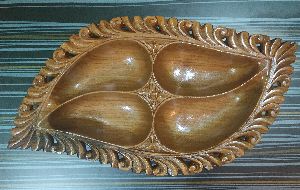
Walnut Wood Dry Fruit Bowl
1 Piece (MOQ)
Kashmir walnut wood hand carved paisley design dry fruit bowl. These bowls are available in different shapes & sizes.
Material : Walnut Wood
Shape : Available In Different Shape
Color : Brown
Feature : Durable,Light Weight
Pattern : Hand Carved
...more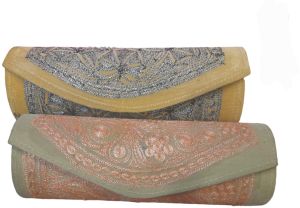
Kashmiri Tilla Work Round Pouches
550 - 650 Per Piece
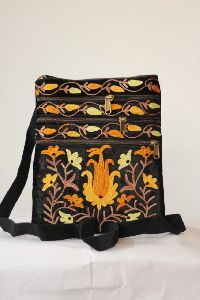
Kashmiri Sling Bags
1 Piece (MOQ)
Pattern : Embroidered
Color : Available in Different Color
Technics : Machine Made
Closure Type : Zipper
Specialities : Durable, Fashionable
Usage : Shopping Bag
Strap Type : Single Handle
...more
Kashmiri Pheran
1 Piece (MOQ)
Pheran is part of the Kashmiri culture, fashion, and daily life. Men, women, and children, all wear it. Pheran is a traditional long dress that covers the entire body up to the knees. Pherans worn by men are of simple design, made of tweed wool and usually black, brown, or grey in color. Women wear colorful pherans with embroideries like aari, sozni, and tilla work. Women phirans are available in different materials like Cashmilon, Raffal, Count, Velvet, and Tweed.
Suit Style : Kashmiri
Color : Available In Different Color
Sleeve Style : Full Sleeves
Size : Small, Medium, Large, XL, XXL
Wash Care : Hand Wash
...more
Kashmiri Pashmina Turma Scarves
1 Piece (MOQ)
Kashmiri Turma made from the finest quality of 100% authentic Kashmiri Pashmina. The Turma or head shawl is very popular in the middle eastern markets. The highest quality of Pashmina Turma used in the middle east. The size of this turns is 56" / 56".
Material : Pashmina
Knitting Type : Machine Made
Wash Care : Hand Wash
Color : Available in Different Color
Pattern : Embroidered
Specialties : Impeccable Finish, Anti-Wrinkle
Occasion : Party Wear, Casual Wear
...more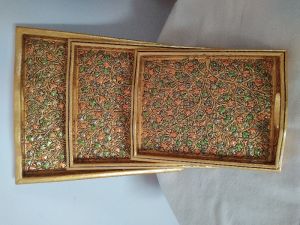
Kashmiri Paper Mache Tray
1 Piece (MOQ)
Paper mache was introduced to India in the 14th century by the Persian mystic Mir Syed Ali Hamdani. He was visiting the Kashmir region from Persia, and brought along skilled artisans and craftsmen.The Persian method of making paper mache melded with similar art forms from Central Asia, and a unique branch of the art of paper mache was born. Over time, Kashmiri artisans added their own flourishes to the art form, bringing attention to their creations from all around the world. There are two important aspects of Kashmiri paper mache- Sakhtsazi and Naqashi. The first step, Sakhtsazi, involves making the foundation of the paper mache figurine or object with the paper pulp, while Naqashi is the final step of painting and decoration. In the Sakhtsazi stage of making a Kashmiri paper mache item, the paper pulp is soaked in water for three or four days. It is then put in a stone mortar and ground so that all of the paper is uniform in its consistency. The pulp gets left in the sun to dry before being mixed with atji, a kind of rice glue. A mold made of clay or wood allows the artist to shape the paper and glue mixture around it. The paper is taken off the mold before it is completely dry, and then shaped and lacquered to make the outside smooth. After the item has gone through the smoothing process, a thin layer of butter paper protects the outside and will eventually keep the outer layer of paint from cracking off the finished product. During the Naqashi stage, a base coat of paint is applied. Then the artist makes their design by hand on the outside of the paper mache object, which means no Kashmiri paper mache item is the same. Traditional artists often use colors derived from minerals, organic, or vegetable bases. Common themes that appear on Kashmiri paper mache products include flowers, box patterns, jungle motifs, and Kashmiri symbols like almonds and the chinar, a five-pointed leaf.
Material : Wooden
Shape : Square
Usage : For Serving
Color : Brown
Feature : Durable, Light Weight
Pattern : Embroidered
...more
Kashmiri Paper Mache Samovar Jug
1 Piece (MOQ)
Paper mache was introduced to India in the 14th century by the Persian mystic Mir Syed Ali Hamdani. He was visiting the Kashmir region from Persia, and brought along skilled artisans and craftsmen.The Persian method of making paper mache melded with similar art forms from Central Asia, and a unique branch of the art of paper mache was born. Over time, Kashmiri artisans added their own flourishes to the art form, bringing attention to their creations from all around the world. There are two important aspects of Kashmiri paper mache- Sakhtsazi and Naqashi. The first step, Sakhtsazi, involves making the foundation of the paper mache figurine or object with the paper pulp, while Naqashi is the final step of painting and decoration. In the Sakhtsazi stage of making a Kashmiri paper mache item, the paper pulp is soaked in water for three or four days. It is then put in a stone mortar and ground so that all of the paper is uniform in its consistency. The pulp gets left in the sun to dry before being mixed with atji, a kind of rice glue. A mold made of clay or wood allows the artist to shape the paper and glue mixture around it. The paper is taken off the mold before it is completely dry, and then shaped and lacquered to make the outside smooth. After the item has gone through the smoothing process, a thin layer of butter paper protects the outside and will eventually keep the outer layer of paint from cracking off the finished product. During the Naqashi stage, a base coat of paint is applied. Then the artist makes their design by hand on the outside of the paper mache object, which means no Kashmiri paper mache item is the same. Traditional artists often use colors derived from minerals, organic, or vegetable bases. Common themes that appear on Kashmiri paper mache products include flowers, box patterns, jungle motifs, and Kashmiri symbols like almonds and the chinar, a five-pointed leaf.
Type : Jug Kettle
Material : Wooden
Color : Available in Different Color
Capacity : 0-3L
...more
Kashmiri Paper Mache Jewellery Box
1 Piece (MOQ)
Paper mache was introduced to India in the 14th century by the Persian mystic Mir Syed Ali Hamdani. He was visiting the Kashmir region from Persia, and brought along skilled artisans and craftsmen.The Persian method of making paper mache melded with similar art forms from Central Asia, and a unique branch of the art of paper mache was born. Over time, Kashmiri artisans added their own flourishes to the art form, bringing attention to their creations from all around the world. There are two important aspects of Kashmiri paper mache- Sakhtsazi and Naqashi. The first step, Sakhtsazi, involves making the foundation of the paper mache figurine or object with the paper pulp, while Naqashi is the final step of painting and decoration. In the Sakhtsazi stage of making a Kashmiri paper mache item, the paper pulp is soaked in water for three or four days. It is then put in a stone mortar and ground so that all of the paper is uniform in its consistency. The pulp gets left in the sun to dry before being mixed with atji, a kind of rice glue. A mold made of clay or wood allows the artist to shape the paper and glue mixture around it. The paper is taken off the mold before it is completely dry, and then shaped and lacquered to make the outside smooth. After the item has gone through the smoothing process, a thin layer of butter paper protects the outside and will eventually keep the outer layer of paint from cracking off the finished product. During the Naqashi stage, a base coat of paint is applied. Then the artist makes their design by hand on the outside of the paper mache object, which means no Kashmiri paper mache item is the same. Traditional artists often use colors derived from minerals, organic, or vegetable bases. Common themes that appear on Kashmiri paper mache products include flowers, box patterns, jungle motifs, and Kashmiri symbols like almonds and the chinar, a five-pointed leaf.
Material : Paper
Shape : Available In Different Shape
Color : Available In Different Color
Feature : Durable, Eco Friendly
Storage Capacity : 1kg, 500gm
...more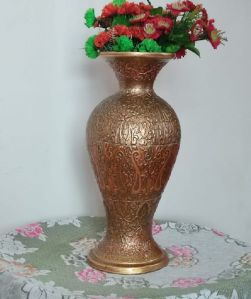
Kashmiri Paper Mache Flower Pots
1 Piece (MOQ)
Paper mache was introduced to India in the 14th century by the Persian mystic Mir Syed Ali Hamdani. He was visiting the Kashmir region from Persia, and brought along skilled artisans and craftsmen.The Persian method of making paper mache melded with similar art forms from Central Asia, and a unique branch of the art of paper mache was born. Over time, Kashmiri artisans added their own flourishes to the art form, bringing attention to their creations from all around the world. There are two important aspects of Kashmiri paper mache- Sakhtsazi and Naqashi. The first step, Sakhtsazi, involves making the foundation of the paper mache figurine or object with the paper pulp, while Naqashi is the final step of painting and decoration. In the Sakhtsazi stage of making a Kashmiri paper mache item, the paper pulp is soaked in water for three or four days. It is then put in a stone mortar and ground so that all of the paper is uniform in its consistency. The pulp gets left in the sun to dry before being mixed with atji, a kind of rice glue. A mold made of clay or wood allows the artist to shape the paper and glue mixture around it. The paper is taken off the mold before it is completely dry, and then shaped and lacquered to make the outside smooth. After the item has gone through the smoothing process, a thin layer of butter paper protects the outside and will eventually keep the outer layer of paint from cracking off the finished product. During the Naqashi stage, a base coat of paint is applied. Then the artist makes their design by hand on the outside of the paper mache object, which means no Kashmiri paper mache item is the same. Traditional artists often use colors derived from minerals, organic, or vegetable bases. Common themes that appear on Kashmiri paper mache products include flowers, box patterns, jungle motifs, and Kashmiri symbols like almonds and the chinar, a five-pointed leaf.
Material : Wooden
Shape : Available In Different Shape
Application : Decorating Flower
Color : Available In Different Color
Feature : Fine Finish, Unique Designs
Finishing : Polished
...more
Kashmiri Paper Mache Elephant
1 Piece (MOQ)
Paper mache was introduced to India in the 14th century by the Persian mystic Mir Syed Ali Hamdani. He was visiting the Kashmir region from Persia, and brought along skilled artisans and craftsmen.The Persian method of making paper mache melded with similar art forms from Central Asia, and a unique branch of the art of paper mache was born. Over time, Kashmiri artisans added their own flourishes to the art form, bringing attention to their creations from all around the world. There are two important aspects of Kashmiri paper mache- Sakhtsazi and Naqashi. The first step, Sakhtsazi, involves making the foundation of the paper mache figurine or object with the paper pulp, while Naqashi is the final step of painting and decoration. In the Sakhtsazi stage of making a Kashmiri paper mache item, the paper pulp is soaked in water for three or four days. It is then put in a stone mortar and ground so that all of the paper is uniform in its consistency. The pulp gets left in the sun to dry before being mixed with atji, a kind of rice glue. A mold made of clay or wood allows the artist to shape the paper and glue mixture around it. The paper is taken off the mold before it is completely dry, and then shaped and lacquered to make the outside smooth. After the item has gone through the smoothing process, a thin layer of butter paper protects the outside and will eventually keep the outer layer of paint from cracking off the finished product. During the Naqashi stage, a base coat of paint is applied. Then the artist makes their design by hand on the outside of the paper mache object, which means no Kashmiri paper mache item is the same. Traditional artists often use colors derived from minerals, organic, or vegetable bases. Common themes that appear on Kashmiri paper mache products include flowers, box patterns, jungle motifs, and Kashmiri symbols like almonds and the chinar, a five-pointed leaf.
Material : Wood
Application : Home Decor
Color : Available In Different Color
Feature : Light Weight, Unique Design
Finishing : Polished
Packaging Type : Box
...more
Kashmiri Handbags
2,500 - 5,000 Per Piece
1 Piece (MOQ)
Kashmiri handbags, purses, clutches, sling bags and other embroidery bags are known world over for quality and design. Due to their splendid colors and graceful demeanor, these can be paired with any traditional or western outfit. The Kashmiri Aari & Crewel kari on these bags will make you stand out when you take these with you for shopping trips, parties, professional settings and other occasions.
Color : Available In Different Color
Pattern : Embroidered
Packaging Type : Plastic Packet
Load Capacity : 5-10 Kg
Closure Type : Magnet Button
Strap Type : Single Handle, Double Handle, Adjustable Strap
Specialities : Durable, Fashionable
Wash Care : Hand Wash
...more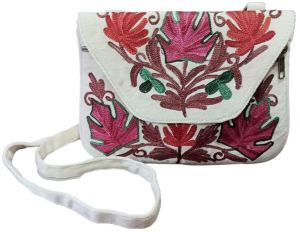
Kashmiri Embroidery Croco Sling Bags
350 - 400 Per Piece
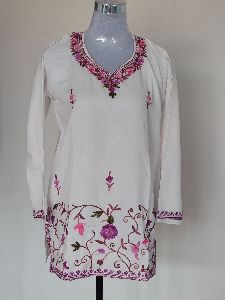
Kashmiri Embroidered Tops
1 Piece (MOQ)
We offer Kashmiri embroidery Tops. These Tops are available in assorted colors & designs. Also available in cotton, silk, wool & velvet fabrics. The types of Embroidery of these tops are Aari Embroidery & Tilla Work Embroidery.
Size : L, M, S, XL, XXL
Color : Available in Different Color
Season : Winter
Feature : Fad Less Color, Impeccable Finish
Technics : Embroidered
Occasion : Casual Wear
Sleeve Style : Long Sleeve
...more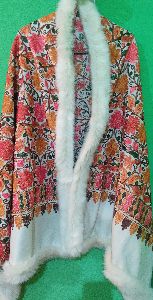
kashmiri embroidered stoles
1 Piece (MOQ)
Soft to touch, and exceptionally graceful to wear, Kashmiri shawls convey the finest skills of Kashmiri artisans as well as display the sophisticated aesthetic of their wearer. It is said about the Kashmiri shawls that none excels in colour, design, beauty, hand embroideries, and texture as the famous Kashmiri shawls do. Types of Kashmiri Shawls The base fabric of Kashmiri shawls is of three types - Shahtoosh, Pashmina and Raffal. Shahtoosh is called the king of wool. It is often known by the name “ring Shawl” because it is so fine that it can pass through a ring. Shahtoosh wool comes from the Tibetan antelope Chiru, which is found over 14000 feet in the wilds of the Himalayas. Pashmina is another category of Kashmiri shawls, and their origin is Changthang, Ladakh. Pashmina shawls are made from Cashmere wool, which grows on the body of the Changthangi goat found in Ladakh. The goat is found over 14000 feet and is reared by nomadic herders of Ladakh. Raffal is the third category of Kashmiri shawls. It is spun out of Merino wool, and is the most popular in Kashmir, due to its warmth and cheap price. Types of Hand Embroideries for Kashmiri Shawls A number of hand embroideries are done on Kashmiri shawls depending upon the base fabric. Fine shawls like Pashmina are delicate, and hence lighter versions of embroideries are done on them. Sturdier bases like that of a merino wool shawl do host thicker forms of Kashmiri embroideries. Let us have a look at the embroidery types done in the valley. SOZNI EMBROIDERY Pashmina is handwoven and hence fine and delicate enough to tear if dealt with harshly. Hence the best-suited embroidery for these beauties is Sozni Kari. After the shawl is woven, a Naqash uses block prints to make the outline of the design, which are usually traditional designs. These designs have emerged from Persian-inspired Paisley which the Mughals introduced, floral patterns which bloom in the valley itself in Spring and summer, and many other designs. Embroidery artisans have the choice to select colour for a particular shawl. They have decades of experience and depending upon the base colour, they select a complementing shade, which is influenced by the fashion trends in vogue. Sozni mostly uses cotton threads, but sometimes even silk is used. Fine needles are used to embroider motifs onto the gossamer base. The amount of embroidery to be done over the shawl decides the time in which it will be completed. Jaali shawls are less heavy, while tuki Jama is laden with embroidery motifs. Tuki Jama shawls take even years to get ready. PAPIER MACHE EMBROIDERY Papier Mache or Paper Mache embroidery is a form of embroidery which might be considered as a bolder variant of Sozni. It consists of breathtaking motifs which are worked in a bright coloured satin thread. Motifs are outlined in black to give a protruding effect. Paper Mache uses thicker needle and thread for a more appealing visual effect. TILLA EMBROIDERY An embroidery which makes shawls relatively expensive is Tilla embroidery. This type is so popular in the valley that every bride should have at least one phiran (a garment worn by Kashmiri women) embroidered with tilla embroidery in her trousseau. Or else a shawl ornate with Tilla embroidered is expected by the onlookers. Tilla originated from a village called “Zari” in Iran. But when Syed Ali Hamdani, a Sufi saint travelled to Kashmir with his artisans, he introduced the same in the local community. The then ruling Mughals were fascinated by its royal demeanour, and used this embroidery in their royal courts.
Fabric : Wool
Color : Available In Different Color
Technics : Embroidered
Occasion : Casual Wear
Wash Care : Machine Wash
Summer : Winter
Speaciality : Skin Friendly, Comfortable
...more
kashmiri embroidered shawls
1 Piece (MOQ)
Soft to touch, and exceptionally graceful to wear, Kashmiri shawls convey the finest skills of Kashmiri artisans as well as display the sophisticated aesthetic of their wearer. It is said about the Kashmiri shawls that none excels in colour, design, beauty, hand embroideries, and texture as the famous Kashmiri shawls do. Types of Kashmiri Shawls The base fabric of Kashmiri shawls is of three types - Shahtoosh, Pashmina and Raffal. Shahtoosh is called the king of wool. It is often known by the name “ring Shawl” because it is so fine that it can pass through a ring. Shahtoosh wool comes from the Tibetan antelope Chiru, which is found over 14000 feet in the wilds of the Himalayas. Pashmina is another category of Kashmiri shawls, and their origin is Changthang, Ladakh. Pashmina shawls are made from Cashmere wool, which grows on the body of the Changthangi goat found in Ladakh. The goat is found over 14000 feet and is reared by nomadic herders of Ladakh. Raffal is the third category of Kashmiri shawls. It is spun out of Merino wool, and is the most popular in Kashmir, due to its warmth and cheap price. Types of Hand Embroideries for Kashmiri Shawls A number of hand embroideries are done on Kashmiri shawls depending upon the base fabric. Fine shawls like Pashmina are delicate, and hence lighter versions of embroideries are done on them. Sturdier bases like that of a merino wool shawl do host thicker forms of Kashmiri embroideries. Let us have a look at the embroidery types done in the valley. SOZNI EMBROIDERY Pashmina is handwoven and hence fine and delicate enough to tear if dealt with harshly. Hence the best-suited embroidery for these beauties is Sozni Kari. After the shawl is woven, a Naqash uses block prints to make the outline of the design, which are usually traditional designs. These designs have emerged from Persian-inspired Paisley which the Mughals introduced, floral patterns which bloom in the valley itself in Spring and summer, and many other designs. Embroidery artisans have the choice to select colour for a particular shawl. They have decades of experience and depending upon the base colour, they select a complementing shade, which is influenced by the fashion trends in vogue. Sozni mostly uses cotton threads, but sometimes even silk is used. Fine needles are used to embroider motifs onto the gossamer base. The amount of embroidery to be done over the shawl decides the time in which it will be completed. Jaali shawls are less heavy, while tuki Jama is laden with embroidery motifs. Tuki Jama shawls take even years to get ready. PAPIER MACHE EMBROIDERY Papier Mache or Paper Mache embroidery is a form of embroidery which might be considered as a bolder variant of Sozni. It consists of breathtaking motifs which are worked in a bright coloured satin thread. Motifs are outlined in black to give a protruding effect. Paper Mache uses thicker needle and thread for a more appealing visual effect. TILLA EMBROIDERY An embroidery which makes shawls relatively expensive is Tilla embroidery. This type is so popular in the valley that every bride should have at least one phiran (a garment worn by Kashmiri women) embroidered with tilla embroidery in her trousseau. Or else a shawl ornate with Tilla embroidered is expected by the onlookers. Tilla originated from a village called “Zari” in Iran. But when Syed Ali Hamdani, a Sufi saint travelled to Kashmir with his artisans, he introduced the same in the local community. The then ruling Mughals were fascinated by its royal demeanour, and used this embroidery in their royal courts.
Material : Woolen
Color : Available In Different Color
Gender : Female
Season : Winter
Feature : Anti-Wrinkle, Comfortable
Technics : Embroidered
...more
Kashmiri Embroidered Poncho
1 Piece (MOQ)
Kashmiri Embroidered Woolen Poncho. This elegant and beautifully embroidered Kashmiri woolen Poncho is a unique winter accessory that looks lovely and unusual. Kashmiri stoles and shawls are popular for their warmth, softness and appeal. The embroidery worked on some of them is a special to Kashmir. 'Sozni' or needlework is generally done in a panel along the sides of the shawl. Other unique types of needle embroidery include Papier Mache` work because of the design and the style in which it is executed and the 'Ari' or hook embroidery where floral motifs are finely worked in concentric rings of chain stitch.
Size : L, M, S, XL
Material : Cashmere Wool
Color : Available in Different Color
Gender : Female
Feature : Attractive Design, Washable
Pattern : Embroidered
...more
kashmiri embroidered kurtis
1 Piece (MOQ)
These Kurtis are available in assorted colors & designs. Also available in cotton, silk, wool & velvet fabrics. The types of Embroidery of these tops are Aari Embroidery & Tilla Work Embroidery.
Color : Available in Different Color
Pattern : Embroidered
Ethnic Region : Kashmir
Neck Shape : Round Neck
Season : Winter
Stitch Type : Stitched
Wash Care : Handwash
...more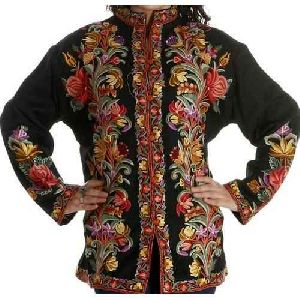
Kashmiri Embroidered Jacket
1 Piece (MOQ)
Color : Available in Different Color
Gender : Female
Pattern : Embroidered
Occasion : Casual Wear
Sleeve Style : Full Sleeves
Fabric : Woolen
Opening Style : Non Zipper
Speciality : Easy To Fit, Compact Size
...more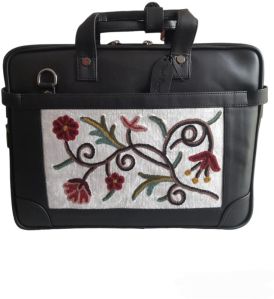
Kashmiri Crewal Embroidery Laptop Bags for Unisex
1,500 - 1,600 Per Piece
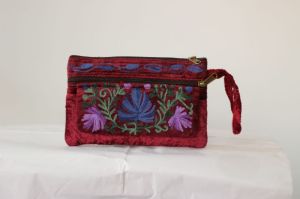
Kashmiri Clutch
1 Piece (MOQ)
Kashmiri handbags, purses, clutches, sling bags and other embroidery bags are known world over for quality and design. Due to their splendid colors and graceful demeanor, these can be paired with any traditional or western outfit. The Kashmiri Aari & Crewel kari on these bags will make you stand out when you take these with you for shopping trips, parties, professional settings and other occasions.
Color : Available in Different Color
Gender : Female
Feature : Fine Finishing, Standard Quality
...more
Kashmiri Chain Stitch Table Runner
1 Piece (MOQ)
Chain Stitch - Natively known as "Jalakdozi", chain stitch rugs are the speciality of Kashmir. These rugs are made on "hessain cloth" or hand made cotton cloth, in continued stitch with superior woolen or silken yarn, with the help of a hook type tool natively called "Aurah". 100% Woolen / Silk hand embroidered chainstitch rugs come in sizes from 2x3 feet to 9x12. Though traditional patterns are mostly floral, we offer a wide range of chain stitch rugs.
Size : Available In Different Size
Material : Silk, Wool
Application : On Table
Color : Available In Different Color
Pattern : Embroidered
Appearance : Classy
...more
Kashmiri Chain Stitch Rugs
1 Piece (MOQ)
Chain Stitch - Natively known as "Jalakdozi", chain stitch rugs are the speciality of Kashmir. These rugs are made on "hessain cloth" or hand made cotton cloth, in continued stitch with superior woolen or silken yarn, with the help of a hook type tool natively called "Aurah". 100% Woolen / Silk hand embroidered chainstitch rugs come in sizes from 2x3 feet to 9x12. Though traditional patterns are mostly floral, we offer a wide range of chain stitch rugs.
Pattern : Embroidered
Shape : Rectangular
Technique : Hand Woven
Color : Available in Different Color
Wash Care : Hand Wash
Speciality : Long Life, Durable
Usage : Home, Hotel
Packaging Type : Roll
...more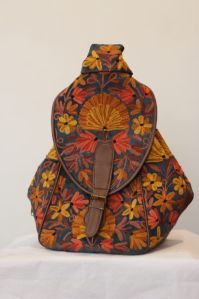
Kashmiri Backpack Bag
1 Piece (MOQ)
Kashmiri handbags, purses, clutches, sling bags and other embroidery bags are known world over for quality and design. Due to their splendid colors and graceful demeanor, these can be paired with any traditional or western outfit. The Kashmiri Aari & Crewel kari on these bags will make you stand out when you take these with you for shopping trips, parties, professional settings and other occasions.
Size : Available in Different Size
Style : Backpack
Color : Available in Different Color
Feature : Easy To Carry, Nice Look
Pattern : Embroidered
...more
Handmade Kashmiri Carpets
1 Piece (MOQ)
A Kashmir rug is a hand-knotted oriental rug from Kashmir valley in India, which is associated with Kashmiri handicrafts. Kashmir rugs or carpets have intricate designs that are primarily oriental, floral style in a range of colors, sizes and quality. The Kashmiri word denotes a native or inhabitant of Kashmir. It also refers to the language of Kashmir. Rug ( /rʌɡ/ ) word is recognised with the floor covering of thick woven material ("an oriental rug"). Kashmir carpets are handmade, hand-knotted, and are primarily made using pure wool, pure silk and occasionally wool and silk blends. These are available in wide-ranging colors, designs and sizes. Kashmir rugs are primarily made in the vicinity of Srinagar, Kashmir in North India and neighboring villages in rural parts of Kashmir. Kashmir rugs are one of the most sought-after artworks by connoisseurs around the world owing to their exceptional workmanship. Kashmir rugs are available in a range of standard sizes, such as 3'x2', 4'x2'6", 5'x3', 6'x4', 7'x5', 10'x8', 12'x9', 14'x10', 15'x12' and 18'x12'. Larger sizes than these dimensions are mostly custom-made. Kashmir rugs are renowned to have bright, jewel-like color tones such as sapphire blue, ruby red, emerald green, aquamarine, amethyst, and ivory. Rugs from Kashmir are traditionally made in oriental, floral designs that typically involve significant and culturally important motifs such as the paisley, chinar tree, (the oriental plane) and tree-of-life. Most of these designs are rooted in the Kashmiri way of life and are a symbolic representation of the age-old Kashmir tradition of hospitality, warmth, and love. It is often said in Kashmir folklore that a home is incomplete without a soul - a Kashmir carpet. The ethos of Kashmir culture is often represented in the motifs of a Kashmir rug. Although, the art of making these gorgeous rugs is not native to Kashmir and was first introduced nearly 400 years back by the Mughal rulers in India. Yet the indigenous brilliance of the local crafts-persons has made Kashmir carpets one of the most sought after works of art in the world. Rugs of Kashmir have always found more appeal due to their quaint designs and an interesting blend of classic colors inspired by the cultural microcosm of Kashmir and at times the colors were contemporary in nature that made carpets of Kashmir widely popular across North America, South Asia and Europe.
Material : Woolen
Shape : Rectangular
Color : Available in Different Color
Wash Care : Machine Wash
Speciality : Soft, Durable
Usage : Home, Hotel
Packaging Type : Roll
...moreBe first to Rate
Rate ThisOpening Hours
QASIM AND SONS is a dependable name developed amongst the prominent exporter of the Kashmiri handicraft involved in offering an excellent range of all types of Kashmiri Embroidered Women Wear, Kashmiri Embroidered Bags, Kashmiri Paper Mache Products, Kashmiri Crewal Home Furnishing, Kashmiri Chain Stitch Products and many more. We are a noticeable supplier of several ranges of handicraft products. Our products are produced by using the finest quality raw material. Also, we collect products straight from our most dependable manufacturers.
Our establishment
Deeply rooted in Srinagar, Jammu & Kashmir, are one of the bulging firms fascinated in the business of supplying a qualitative range of products. Working under the valuable guidance of our founder Mr Wajahat Hassan we are rising day by day in this business domain.
Our Workforce
Our team of open staff endorses that every product is supplied to our valued customers and vendors obtaining the set industrial standards. Our supply network enlarges through the key stores and markets within India.
Our Inventory
We have a well-maintained storehouse prepared with a curiously innovative storage facility. Hence we can store massive quantities and varieties at a time and supply as well. Modern machines and tools are utilized to store and verify the quality of each product properly.
Why Choose Us?
Wide range
Colour selections
Timely delivery
Consistent Quality
Affordable pricing